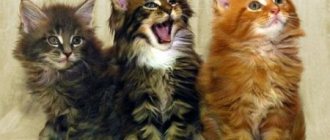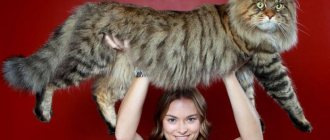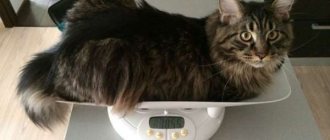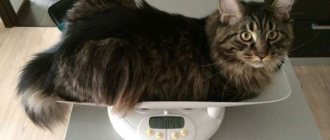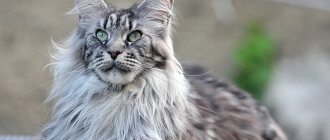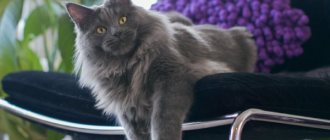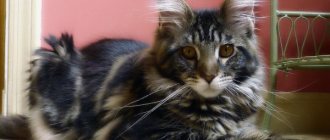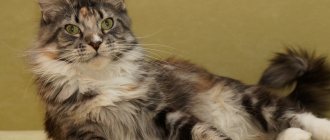Description of the Maine Coon kitten
Let's face it, the main motivation for getting a Maine Coon kitten is the pet's unusual appearance. And this manifests itself literally from the first days of life. The fact is that such a kitten is noticeably larger than ordinary kittens, and by three months of life it reaches the size of an ordinary large cat.
Such a baby has a massive head and a large oblong body with weighty legs. But what is most touching is the thick fur on the nape of the neck, which creates a resemblance to a lion’s mane on a Maine Coon kitten, and the cute tassels on the ears, very reminiscent of lynx tufts.
The look is completed by thick fur with a chic fluffy tail. But the color can be absolutely anything - white, red, gray, smoky, black, or even tri-color.
A little history
This breed was first mentioned in literature in 1878 in the United States of America. Because of the original appearance, there is a version that this breed is a cross between a cat and a lynx, and even more interesting - a mixture of a cat and... a raccoon! And all because of the tassels on the ears, like a lynx, and often a striped tail, like a raccoon. But more on that later.
The most likely version of the origin of Maine Coons is that they descended from American shorthair and foreign longhair cats. At one time in America there were even special nurseries where this breed was bred.
How to choose a Maine Coon kitten
It must be said that the enormous popularity of Maine Coon kittens has contributed to the appearance of unscrupulous sellers on the market who, under the guise of a real Maine Coon, sell mixed-breed or even outbred kittens. To avoid scammers, pay attention to the following points when purchasing:
- Buy a kitten only from trusted breeders who professionally breed Maine Coons. Such people will not risk their reputation.
- Be sure to check the pedigree of both parents of your future pet. By the way, by observing the parents, you can imagine the character of your future pet and decide whether it is suitable for you.
- Pay attention to the sizes. A Maine Coon kitten is two or even three times larger than ordinary kittens. Girls are slightly smaller than boys, but they also surprise with their size.
- Do not buy a Maine Coon kitten until it is 3 months old. By this age, the baby shows all the signs of the breed. He already has a characteristic mane and tufts on his ears, which means that cunning sellers will not be able to fool you.
Character and behavior
The external distinctive features of the Maine Coon are immediately noticeable. But in order to avoid deception, you need to know about the behavior of purebred cats. The Maine Coon breed is characterized by the following habits:
- Passion for cleanliness. Maine Coons, unlike other felines, are not afraid of water. And they enjoy water procedures.
- Mainly living in one favorite place in the house. Cats of this breed love comfort and prefer to spend most of their time in their favorite corner.
- Good attitude towards children. A large cat can often be found frolicking and playing with a child. At the same time, the pet will never harm the baby.
- High physical activity - love for active games, pranks, and performing various tricks.
- Singling out only one person as the master and recognizing his full authority.
Maine Coons have a high level of intelligence compared to other cats. Representatives of this breed are easy to train and are able to carry out simple commands (come to me, give me a paw, sit, lie down).
Despite their menacing appearance, Maine Coon cats have a soft character. They are considered family pets. Pets of this breed are affectionate, have a stable attachment to family members, willingly make contact, and allow themselves to be petted. Maine Coons enjoy spending time with people. Unlike mongrel cats, they do not like loneliness and prefer to be in the company of family members.
Maine Coon cats are also very curious. Pets are constantly interested in what is happening around them, climb into secluded corners of the house, and come up with new activities. Therefore, their owners need to be extremely vigilant. Representatives of this breed land poorly when falling from a height and often get injured or even die while exploring the world around them.
Dimensions of a Maine Coon kitten at birth
According to observations, buyers usually strive to purchase the largest kitten from the litter. However, its size at birth may vary. For example, the average weight of a newborn Maine Coon is 150 grams (while the weight of a regular kitten is 70-80g).
The size of a newborn baby can also be affected by:
Floor. Boys are usually born larger than girls. If a boy in a litter weighs 160g, then a girl weighs 130g.
Number of kittens in the litter. If a cat gives birth to one cub, it can reach a weight of 170 grams, while when 4-5 kittens are born, their average weight will not exceed 140 grams.
Parents' size. The larger the baby's parents, the more he will weigh at birth. By the way, looking at the appearance of your future pet’s mom and dad, you can roughly imagine what your Maine Coon will look like.
Purebred breed. The admixture of cats of other breeds also affects the size of the kitten. It may be significantly smaller than normal size.
Hormonal therapy. If a cat was given hormonal drugs during pregnancy, this could affect the weight of the resulting litter.
Stress. Cats that have experienced a shock, such as separation from their owners or moving to a new place of residence, can also give birth to smaller kittens. By the way, this will also affect their further growth.
Feeding. Finally, the size and weight of the offspring is largely determined by the nutrition that the mother cat received.
Important! A weakened cat gives birth to weakened kittens. They will gain weight more slowly and worse.
Grooming
Maine Coons have beautiful long hair, which brings a lot of trouble to the owners of these cats.
Kittens need daily brushing as they cannot groom their fur yet.
Furminators are suitable for combing kittens' fur (they should not be sharp).
First, the wool is combed with a comb with rare teeth, then with frequent ones. Finally, the wool is brushed with a brush with natural bristles.
Daily brushing will help prevent the formation of tangles and also promote better coat growth.
It is also advisable to brush adult animals every day, especially during shedding. They can also be cut .
The cat has a gorgeous red fur coat, gorgeous thick brushes and breathtaking green eyes.
There is no need to bathe cats often; they are clean animals.
This should be done when necessary: if the wool is dirty or greasy.
For bathing, you need to purchase a special cat shampoo, preferably hypoallergenic (for example, Jerob, Espree).
It also doesn’t hurt to have anti-flea shampoo at home, especially if the pet lives in a private home or other animals live with it.
When bathing, you need to make sure that water does not get into the ears. After bathing, the cat should be thoroughly dried and brushed.
Periods of development of a Maine Coon kitten
In general, the development of a Maine Coon kitten goes through 4 periods until it reaches adulthood:
1. Neonatal. This is the period of the first days of a newborn mole rat’s life, when it feeds exclusively on mother’s milk, and its weight gain is largely determined by the severity of the cat’s birth.
2. Suction. This includes the first month of the kitten's life. At this time, he actively feeds on his mother’s milk, gaining 20-30g in weight every day.
3. Transitional. The name of this period clearly indicates that the matured kitten learns to feed on its own. The transition period covers the second month of a kitten’s life, and its weight gain becomes less (10-20g per day).
4. After suction. This is a long period of time, starting from the age of two months and ending with the full adulthood of the Maine Coon. It is characterized by the kitten's weaning from its mother and the transition to independent feeding. At this time, the baby is actively gaining weight and this process actually continues up to 3 years.
Important! The Maine Coon grows up to about 3 years of age. It is by the age of three that a cat matures both physically and psychologically. However, for another 1-2 years the pet can mature, gaining weight and becoming wider.
No to artificial records
Most often, a weight of over 10 kilograms is observed in “artificial” cats: their diet contained a lot of dietary supplements, which caused metabolic disorders. Under no circumstances should you believe the myths about cats weighing 20 kilograms and chasing weight “records” - this is a sure path to illness and premature death of the animal.
Maine Coons should not be overfed: excess weight provokes diseases of the heart, lungs, internal organs and joints. Representatives of this cat breed are distinguished by good health and endurance, but they also have an innate tendency to cardiomyopathy, spinal muscular atrophy, and hip dysplasia. Excess weight increases the likelihood of developing these difficult-to-treat ailments.
Development of a Maine Coon kitten by month
• 1st month. Immediately after birth, the kitten arrives in stress and gains very little weight. However, then he goes into a routine, starting to eat actively and steadily gain about 20g per day. It is not surprising that by the first month of life the baby exceeds its original weight by almost 4 times. Maine Coon boys weigh about 800g, and girls about 600g.
Important! Around the second week of life, the little cub opens its eyes and begins to explore the world.
• 2 months. The baby continues to feed on mother's milk in the same mode, and therefore the weight increases proportionately. As a result, by the second month of life, boys of this breed weigh 1600 grams, and girls - 1400 grams. However, at this time you can already begin to introduce complementary foods to your baby. This can be boiled meat pureed, baby yoghurts or cottage cheese.
In addition, the kitten is already ready to learn everything new. He masters the tray and enjoys playing with toys. The mother cat plays a huge role in teaching the baby, teaching the baby the rules of behavior, in particular, showing how and where to sharpen its claws.
• 3 months. A three-month-old kitten can be gradually weaned off its mother's milk. The baby is already quite ready to consume dry and wet food, and should eat 4-5 times a day.
In addition, by the age of three months, the little Maine Coon must visit a veterinary clinic and receive all the necessary vaccinations, as well as a veterinary passport.
Important! By the age of three months, the difference in weight between male and female coons becomes noticeable. In addition, kittens exhibit all the characteristic features of this breed.
• 4 months. Around this period, the young Maine Coon finds new owners and moves to a new home. These events become stressful for the animal, and therefore it is possible that the kitten begins to gain weight more slowly. At the same time, the pet goes to the toilet tray without prompting and can be trained.
• 5 months . By the age of five months, the Maine Coon transforms from an angular kitten into a beautiful purebred cat. Its weight, depending on gender, varies between 3-5 kilograms. Growth at this age slows down somewhat, but weight continues to increase.
• 6-9 months. By this period, the cat's baby teeth fall out and permanent teeth appear. Therefore, more foods with calcium (boiled fish, fermented milk products) should appear in his diet. And by this age, the Maine Coon begins to be given frozen meat periodically. To do this, beef cubes are simply frozen in the freezer for a couple of days and given to the cat as a treat.
Moreover, the animal is already going through puberty, which means that the ideal time has come for castration or sterilization if the owners do not plan to further breed Maine Coons.
By the age of one year, the average weight of a Maine Coon is close to 8-9 kilograms. You should not overfeed your pet in pursuit of records. This way you will only harm your four-legged friend by causing obesity, cardiovascular diseases, hormonal imbalance and other serious illnesses that affect life expectancy.
Important! Experts recommend that caring owners keep a diary and note in it the weight and height of the Maine Coon kitten during the first year of life. This will allow you to promptly identify possible deviations if they appear and seek help from a veterinary clinic.
Deviations from the norm
Insufficient weight gain and decreased body weight are allowed only during the initial stage of growth, during the first week of life. At the neonatal stage, weight gain and height depend on the characteristics of labor.
This is interesting! In the first four days, even minor weight loss is allowed, which is steadily restored in the coming days.
If an animal whose age is more than a couple of months loses weight, then it is necessary:
- introduce more high-calorie foods into the diet;
- make a competent change in diet;
- supplement the diet with a vitamin-mineral complex;
- use dietary supplements in feeding that stimulate the appetite, as well as quickly normalize the functioning of the stomach and intestinal tract.
It should be noted that at three to four weeks the kitten’s body weight may gradually decrease, which is explained by the transition of the pet from mother’s milk to solid food. And starting from seven weeks, the animal’s weight gains again.
Important! Solid, complete diets with beneficial microelements, vitamins and minerals promote weight gain.
The owner of a Maine Coon should be wary not only of the pet’s underweight, but also of the pet’s excessive body weight . If necessary, you should consult with veterinary specialists who can correctly determine the cause of deviations from the normal weight and height of the Maine raccoon cat.
If the kitten is not gaining weight
Typically, a similar problem occurs when the coon is not fed correctly. Perhaps the kitten simply does not have enough food that its owners give it. Still, this is a rather large cat. Try to gradually increase your diet and record the results in your diary every day (it’s better to weigh your cat on an electronic scale).
It is possible that the inhibition of weight gain is due to a lack of certain nutrients. This happens especially often with calcium deficiency. In any case, to find out the reason, it is better to take the kitten to a veterinary clinic and undergo an examination.
By the way, practice shows that owners who feed their pets dry food are less likely to encounter weight problems. But those who strive to feed their pets homemade food often experience problems with the balance of nutrients.
Therefore, listen to the recommendations of veterinarians, get vaccinations on time and regularly come for examination with your ward. Compliance with all the rules and recommendations will allow you to raise a beautiful, and most importantly, healthy Maine Coon!
Dry food
The beauty of such food is that it saves time for the owner. If the production is carried out conscientiously, from high-quality ingredients and taking into account the characteristics of the breed, then they may well become the basis of your pet’s diet. Don’t even think about saving for the health of an expensive animal.
Treatment for allergies or stomach problems will cost you more. So don’t even look at food from Whiskas, Friskas or Kitiket. There are many companies that develop food specifically for the Maine Coon breed.
Among them there are well-known ones, such as Royal Canin, Purina or Hills, and there are also little known ones, for example, Eagle Pack, Iams and Eukanuba. At the very beginning of the transition to dry food, you should decide on your choice. Make sure that your furbaby does not have an allergy to this brand. Therefore, do not rush to take large bags. Meat should come first in the composition.
Buy only industrially packaged goods, never buy in bulk. Even if you have completely decided to switch to ready-made dry food, periodically treat your Maine Coon with a piece of raw beef or fresh vegetables. Buy special products to care for your teeth. When choosing food and supplements, consult your veterinarian.

